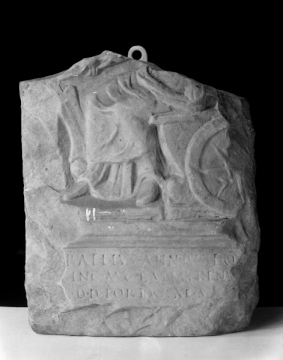Explore Collections


You are here:
CollectionsOnline
/
Fragment of a Roman votive relief to Fortuna Redux
Browse
Fragment of a Roman votive relief to Fortuna Redux
69-96 AD
Probably Flavian
Probably Flavian
Italian marble
Height: 40cm, approximately
Width: 34cm, approximately
Thickness: 9cm
Width: 34cm, approximately
Thickness: 9cm
Inscription: P. AELIVS ANNIVS. EQ / SING. AVG. PALMYRENV / D. D. FORTVNAE. S[...]
P[ublius] Aelius Annius eq[ues] sing[ularis] Aug[usti] Palmyrenu[s] d[onum] d[edit] Fortunae [...]
Inscription note: We are grateful to Dr. Charlotte Tupman, a scholar of epigraphy (the study of inscriptions) undertaking postdoctoral research at King’s College London, who took squeezes of the inscriptions on antiquities in the Museum in 2007, for her transliteration, translation and notes/bibliography of the inscription on this piece.
Inscription translation: Publius Aelius Annius Palmyrenus, eques singularis of the emperor, gave it as a gift to Fortuna...
P[ublius] Aelius Annius eq[ues] sing[ularis] Aug[usti] Palmyrenu[s] d[onum] d[edit] Fortunae [...]
Inscription note: We are grateful to Dr. Charlotte Tupman, a scholar of epigraphy (the study of inscriptions) undertaking postdoctoral research at King’s College London, who took squeezes of the inscriptions on antiquities in the Museum in 2007, for her transliteration, translation and notes/bibliography of the inscription on this piece.
Inscription translation: Publius Aelius Annius Palmyrenus, eques singularis of the emperor, gave it as a gift to Fortuna...
Museum number: M1446
On display: Drawing Office - also known as the Students Room (pre-booked tours only)
All spaces are in No. 13 Lincoln's Inn Fields unless identified as in No. 12, Soane's first house.
For tours https://www.soane.org/your-visit
Curatorial note
Fortuna, in long chiton and himation about the knees, is seated left on a marble throne beside which stands a large, spoked wheel; the extended right hand grasps the tiller of a steering-paddle set on an orb on the ground.
Below her, within traces of a broad fillet and cyma reversa moulding, appears the following carved inscription:
P. AELIVS - ANNIVS . EQ
SING . AVG . PALMYRENV (S)
D.D. FORTUNAE . S . . . .
The Fortuna to whom this relief is dedicated can be identified, because of her seated position and her attributes of wheel, rudder on orb and cornucopia in the left hand, as clearly FORTUNA REDUX.1 This particular figure, found on numerous Roman coins of the second and third centuries AD, undoubtedly presents a side view in relief of the cult statue of Domitian's temple to Fortuna Redux in the Campus Martius in Rome.2 On enlarged views of a bronze medallion of Trebonianus Gallus and Volusianus, this cult image is clearly visible in all details, enthroned within the cella of her temple which is represented as hexastyle. The imperial party sacrifices at an altar in the foreground, and the identification is confirmed by the inscription FORTVNAE REDVCI.3
The major cult-figures of Fortuna, seated or standing, were transmitted in and beyond Rome by images in gold and silver. A number of these and their echoes survive, sources for the sculptor of this relief.4
1 C.V. Daremburg and E. Saglio, Dictionnaire des Antiquités Grecques et Romaines, Paris, 1877-1919, Vol II, 2, p. 1275f.
2 For this temple, and also for the altar of Fortuna Redux erected by the Senate in 19 BC near the Porta Capena, see A.B. Platner, A Topographical Dictionary of Ancient Rome, Boston, 1911, p. 218.
3 Bullettino della Commissione Archeologica comunale di Roma, LXVII, 1939, p. 69f., figs. 5f.; F. Gnecchi, I Medaglioni Romani, Vol II, pl. III, nos. 4, 9, 10.
4 See Greek and Roman Sculpture in Gold and Silver, Boston, 1974, Introduction and pp. 20-22, etc.
Below her, within traces of a broad fillet and cyma reversa moulding, appears the following carved inscription:
P. AELIVS - ANNIVS . EQ
SING . AVG . PALMYRENV (S)
D.D. FORTUNAE . S . . . .
The Fortuna to whom this relief is dedicated can be identified, because of her seated position and her attributes of wheel, rudder on orb and cornucopia in the left hand, as clearly FORTUNA REDUX.1 This particular figure, found on numerous Roman coins of the second and third centuries AD, undoubtedly presents a side view in relief of the cult statue of Domitian's temple to Fortuna Redux in the Campus Martius in Rome.2 On enlarged views of a bronze medallion of Trebonianus Gallus and Volusianus, this cult image is clearly visible in all details, enthroned within the cella of her temple which is represented as hexastyle. The imperial party sacrifices at an altar in the foreground, and the identification is confirmed by the inscription FORTVNAE REDVCI.3
The major cult-figures of Fortuna, seated or standing, were transmitted in and beyond Rome by images in gold and silver. A number of these and their echoes survive, sources for the sculptor of this relief.4
1 C.V. Daremburg and E. Saglio, Dictionnaire des Antiquités Grecques et Romaines, Paris, 1877-1919, Vol II, 2, p. 1275f.
2 For this temple, and also for the altar of Fortuna Redux erected by the Senate in 19 BC near the Porta Capena, see A.B. Platner, A Topographical Dictionary of Ancient Rome, Boston, 1911, p. 218.
3 Bullettino della Commissione Archeologica comunale di Roma, LXVII, 1939, p. 69f., figs. 5f.; F. Gnecchi, I Medaglioni Romani, Vol II, pl. III, nos. 4, 9, 10.
4 See Greek and Roman Sculpture in Gold and Silver, Boston, 1974, Introduction and pp. 20-22, etc.
Acquired by Soane from the collection of the neoclassical sculptor John Flaxman.
Literature
A. Michaelis, Ancient Marbles in Great Britain, trans. C.A.M. Fennell, Cambridge, 1882, p.477, no.25.
Corpus Inscriptiorum Latinarum(CIL), VI, 3174.
Corpus Inscriptiorum Latinarum(CIL), VI, 3174.
Soane collections online is being continually updated. If you wish to find out more or if you have any further information about this object please contact us: worksofart@soane.org.uk


